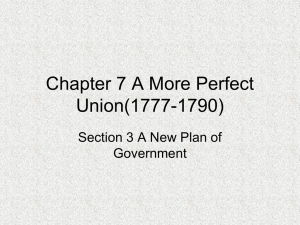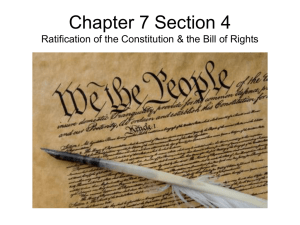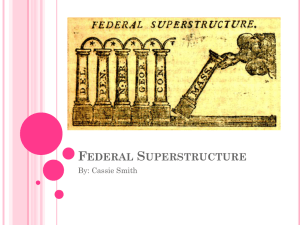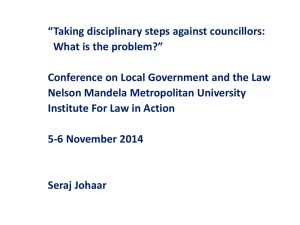ADL+overview+_+revision
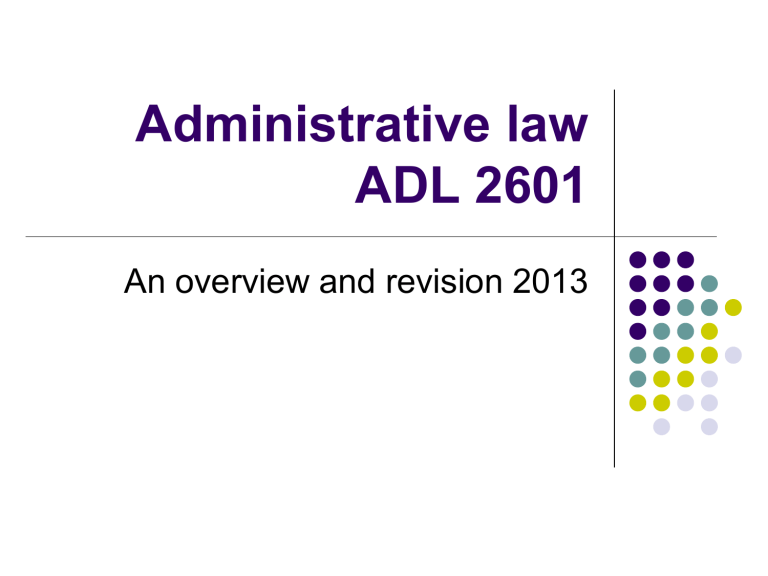
Administrative law
ADL 2601
An overview and revision 2013
Problem statement
The MEC for Roads and Transport, the appointed representative in control of the Department of Roads and Transport in the Gauteng
Province, decides to close all taxi routes and the portion of the taxi ranks operated by the Witwatersrand African Taxi Owners Association
(WATA).
The MEC plans to introduce a new bus service system, which has commonly become known as the Bus Rapid System (BRT).
The purpose of the BRT is to improve public transport in the Gauteng
Province.
WATA is aggrieved by the decision of the MEC and points out that the
BRT can be implemented on other routes where no form of transport is available and furthermore that the consequence would be that its 1200 members would be without jobs.
WATA has persistently tried to make these representations to the MEC.
The MEC has refused to receive their representations and has made no attempt to give reasons for the decision to close all taxi routes and the portion of the taxi ranks operated by WATA.
Problem statement
Breakdown – identify N B parts (quickly write this down)
The MEC for Roads and Transport (representative in control of the Department of Roads and Transport)
Decides to close all taxi routes
Taxi ranks operated by the Witwatersrand African Taxi Owners
Association (WATA)
The MEC plans to introduce a new bus service system (BRT)
The purpose of the BRT is to improve public transport in the
Gauteng Province.
WATA is aggrieved by the decision of the MEC and points out that the BTR can be implemented on other routes where no form of transport is available and furthermore that the consequence would be that its 1200 members would be without jobs.
The MEC has refused to receive WATA’s representations
No attempt by MEC to give reasons for the decision
Where does administrative law fit into the legal system?
Constitutional law / Public law
Administrative law
Labour law OR Environmental law
Question 1:
Identify the organ(s) of state in the set of facts & substantiate your answer with reference to the section in the
Constitution. (5 marks)
The MEC for Roads and Transport, the appointed representative in control of the Department of Roads and Transport in the Gauteng
Province, decides to close all taxi routes and the portion of the taxi ranks operated by the Witwatersrand African Taxi Owners Association
(WATA).
The MEC plans to introduce a new bus service system, which has commonly become known as the Bus Rapid System (BRT).
The purpose of the BRT is to improve public transport in the Gauteng
Province.
WATA is aggrieved by the decision of the MEC and points out that the
BRT can be implemented on other routes where no form of transport is available and furthermore that the consequence would be that its 1200 members would be without jobs.
WATA has persistently tried to make these representations to the MEC.
The MEC has refused to receive their representations and has made no attempt to give reasons for the decision to close all taxi routes and the portion of the taxi ranks operated by WATA.
Identify the organ(s) of state in the set of facts & substantiate your answer with reference to the section in the
Constitution. (5 marks)
Answer
In terms of s 239 of the Constitution the following are organs of state:
The Department of Roads and Transport in the Gauteng
Province: (any department of state or administration in the national, provincial or local sphere of government);
The MEC for Roads and Transport, the appointed representative in control of the Department of Roads and
Transport in the Gauteng Province (any other functionary or institution that (i) exercises a power or performs a function in terms of the Constitution or a provincial constitution/(ii) exercising a public power of performing a public function in terms of any legislation ).
Administrative law relationship
An administrative relationship exists between two or more people where at least one of the subjects is a person or body clothed in state authority who is able to exercise that authority over a person or body in a subordinate position whose rights are affected by the action. It is an unequal relationship.
In a general administrative-law relationship the legal rules governing the relationship between the parties apply to all the subjects in a particular group. It is created by, changed and terminated by legislation. An individual administrative-law relationship the rules apply personally and specifically between the parties. The relationship is created by individual administrative decisions.
Administrative law relationship
Question:
Briefly explain what an administrative-law relationship is. Do you think
WATA is a subject of an administrative-law relationship? (7 marks)
The MEC for Roads and Transport, the appointed representative in control of the Department of Roads and Transport in the Gauteng
Province, decides to close all taxi routes and the portion of the taxi ranks operated by the Witwatersrand African Taxi Owners Association
(WATA).
The MEC plans to introduce a new bus service system, which has commonly become known as the Bus Rapid System (BRT).
The purpose of the BRT is to improve public transport in the Gauteng
Province.
WATA is aggrieved by the decision of the MEC and points out that the
BRT can be implemented on other routes where no form of transport is available and furthermore that the consequence would be that its 1200 members would be without jobs.
WATA has persistently tried to make these representations to the MEC.
The MEC has refused to receive their representations and has made no attempt to give reasons for the decision to close all taxi routes and the portion of the taxi ranks operated by WATA.
Briefly explain what an administrative-law relationship is. Do you think
WATA is a subject of an administrative-law relationship?
(7 marks) Answer:
An administrative-law relationship exists between two parties in an unequal relationship. One of the subjects is a person or body clothed in state authority who is able to exercise that authority over a person or body in a subordinate position whose rights are affected by the action. WATA is a subject of an administrative-law relationship (an individual administrative-law relationship where rules apply personally and specifically between the parties and the relationship is created by individual administrative decisions).
NBNB Remember to apply your answer to the set of facts!!!
Legal subjects of administrative-law relationship
From the above discussion of the administrative law relationship it emerged that one of the subjects of this relationship is the authoritative party and that the other subject is in a subordinate position. You should be able to identify each of the subjects of the administrative-law relationship.
Identification of the authoritative party: In order to identify the authoritative party you must know the definition of an organ of state as contained in section 239 of the Constitution!
In terms of s 239 of the Constitution an organ of state includes:
(a) any department of state or administration in the national, provincial or local sphere of government; or (b) any other functionary or institution that (i) exercises a power or performs a function in terms of the Constitution or a provincial constitution; or (ii) exercises a public power or performs a public function in terms of any legislation. A court and judicial officers are excluded.
Legal subjects of administrative-law relationship
Application to the facts:
Who is the party with authority?
The Department of Roads and Transport in the Gauteng Province: (any department of state or administration in the national, provincial or local sphere of government)
The MEC for Roads and Transport, the appointed representative in control of the
Department of Roads and Transport in the Gauteng Province (any other functionary or institution that (i) exercises a power or performs a function in terms of the
Constitution or a provincial constitution)
Who is the party in the subordinate position?
Witwatersrand African Taxi Owners Association (WATA)
Why?
An administrative relationship exists between two or more people where at least one of the subjects is a person or body clothed in state authority who is able to exercise that authority over a person or body in a subordinate position whose rights are affected by the action. It is an unequal relationship.
Sources of administrative law
Take note
Should be able to answer a short question on this distinction
Binding
Constitution
Legislation
Case law
Common law
Administrative practice
International law
Persuasive
Academic writings
Policy documents
Reports
(from chap 9 institutions)
Foreign law
Administrative action
(unit 5 of study guide)
Section 1 of PAJA provides as follows:
Administrative action means a decision taken or failure to take a decision by
(a) an organ of state in exercising a power in terms of the Constitution or a provincial constitution, or in exercising a public power or performing a public function in terms of any legislation; or
(b) a natural or juristic person which is not an organ of state when exercising a public power or performing a public function in terms of an empowering provision, which adversely affects the rights of any person and which has a direct external legal effect.
PAJA also defines: ‘decision’ as being of an administrative nature under an empowering statute taken by an organ of state as defined in s 239 of the
Constitution.
There are a number of exceptions to the definition, such as the legislative powers of the national, provincial and municipal legislatures, as well as their respective executive powers
You MUST be able to identify the exclusions
Question:
Identify the administrative action in the set of facts. In your answer you should give a full definition of the concept “administrative action” with reference to the provisions of PAJA (13 marks):
The MEC for Roads and Transport, the appointed representative in control of the Department of Roads and Transport in the Gauteng
Province, decides to close all taxi routes and the portion of the taxi ranks operated by the Witwatersrand African Taxi Owners Association
(WATA).
The MEC plans to introduce a new bus service system, which has commonly become known as the Bus Rapid System (BRT).
The purpose of the BRT is to improve public transport in the Gauteng
Province.
WATA is aggrieved by the decision of the MEC and points out that the
BRT can be implemented on other routes where no form of transport is available and furthermore that the consequence would be that its 1200 members would be without jobs.
WATA has persistently tried to make these representations to the MEC.
The MEC has refused to receive their representations and has made no attempt to give reasons for the decision to close all taxi routes and the portion of the taxi ranks operated by WATA.
Identify the administrative action in the set of facts. In your answer you should give a full definition of the concept “administrative action” with reference to the provisions of PAJA.
(13 marks) Answer:
Section 1 of PAJA defines " administrative action” as any decision taken, or any failure to take a decision, by -
(a) an organ of state, when-
(i) exercising a power in terms of the Constitution or a provincial constitution; or
(ii) exercising a public power or performing a public function in terms of any legislation; or
(b) a natural or juristic person, other than an organ of state, when exercising a public power or performing a public function in terms of an empowering provision, which adversely affects the rights of any person and which has a direct, external legal effect.
There are exceptions to the definition. Give an example.
The decision to close all taxi routes and the portion of the taxi ranks operated by
WATA amounts to administrative action because it complies with the definition in that it involves a decision by an organ of state (the MEC for Roads and Transport, the appointed representative in control of the Department of Roads and Transport in the
Gauteng Province) exercising a power in terms of the Constitution or a provincial constitution which has adversely affected the rights of a person (WATA) and which appears to have had a direct external legal effect.
Just administrative action
Units 6-10
The requirements of just administrative action are set out in section 33 of the Constitution. Just administrative action must be: lawful reasonable procedurally fair and written reasons must be provided for administrative action that adversely affects rights
Note that various overarching concepts are used to describe just administrative action ie intra vires/ultra vires ; applying one’s mind to the matter and legality.
Legality
(Context regarding “just” administrative action)
What do we mean by administrative legality?
A principle used by the courts to determine whether administrative action was not only authorised by law but also performed in accordance with the prescripts laid down by the law.
That the public administration must serve and promote the public interest, protect and respect fundamental/human rights.
What does this principle mean in the constitutional framework?
The Constitution is the supreme law of the country and is elevated above all state legislation. Section 2 of the Constitution provides that any law or conduct that is not in line with the Constitution may be declared invalid by the court.
Fedsure Life Assurance LTD v Greater Johannesburg 1999 (1) SA 374 (CC): the executive “may exercise no power and perform no function beyond that conferred upon them by law.”
Section 8 of the Constitution provides that the Bill of Rights binds the executive authority
– state administration in all spheres of government – and all organs of state.
This means that organs of state and individuals exercising public power are bound by the law and not elevated above it.
Lawfulness
(unit 7)
To be ‘lawful’ an administrative action must comply with all the requirements of the law. This guarantees compliance with all the statutory and common-law requirements, ie the Constitution, PAJA, the empowering legislation and common-law rules and principles, ie all the sources of administrative law.
This entrenches the principle of legality.
The concept of lawfulness is further underpinned by the Constitution in its supremacy clause and the requirement that all organs of state must comply with all law.
It is also the concept of administrative justice which is the overarching requirement for the validity of all administrative action.
Administrative authority and power derive mainly from legislation.
Legislation that confers administrative authority is termed empowering legislation. In such empowering legislation you will find specific directives relating to the scope, content or nature of administrative power.
An administrator must act within the powers conferred on him or her by empowering legislation. In this regard you must know the rules that apply when delegation of powers is permitted, see page 110.
Reasonable administrative action (unit 8)
Will a decision be reasonable (justifiable) when there is no evidence of an even balance – proportionality – between the outcome the decision-maker wants to achieve and the means he or she uses to achieve the result?
In order to answer this question you have to consider Roman v
Williams . According to Van Deventer J (at 1278):
“Administrative action, in order to prove justifiable in relation to the reasons given for it, must be objectively tested against the three requirements of suitability, necessity and proportionality which requirements involve a test of reasonableness. Gross unreasonableness is no longer a requirement for review. The constitutional test embodies the requirement of proportionality between the means and the end.”
Write one paragraph explaining the concept “proportionality” in your own words.
Reasonable administrative action:
PAJA and the Constitutional Court’s interpretation of “reasonable administrative action”
In terms of PAJA:
PAJA gives effect to the right to reasonable administrative action by giving an individual the capacity under section 6(1) “to institute proceedings in a court or a tribunal for the judicial review of an administrative action” on the ground that:
“the exercise of the power or the performance of the function authorised by the empowering provision, in pursuance of which the administrative action was purportedly taken, is so unreasonable that no reasonable person could have exercised the power or performed the function
” (section 6(2)(h))
Make a summary of this ground of review. (Refer to the next two slides).
Reasonable administrative action:
PAJA and the Constitutional Court’s interpretation of
“reasonable administrative action”
PAJA stopped short of providing a wide and general ground of review based on the effect or consequence of the action.
The ground for review is limited to the requirement of "action which is so unreasonable that no reasonable person could have exercised it" -a
"reasonable person test"
This particular test preferred by the legislature is more or less similar to the formulation we find in the English decision and now known as "Wednesbury unreasonableness" or the "Wednesbury test".
The CC gave meaning to the content of sec 6(2)(h) in the case of Bato Star
Fishing (Pty) Ltd v Minister of Environment Affairs 2004 4 SA 490.
O’Regan J emphasised the importance of reading section 6(2)(h) in line with the wording of section 33(1) of the Constitution.
Reasonable administrative action:
PAJA and the Constitutional Court’s interpretation of
“reasonable administrative action” (continue)
According to O’Regan J, “even if it may be thought that the language of section
6(2)(h), if taken literally, might set a standard such that a decision would rarely if ever be found unreasonable, that is not the proper constitutional meaning which should be attached to the subsection. The subsection must be construed consistently with the
Constitution and in particular section 33 which requires a simple test, namely that an administrative decision will be reviewable if it is one that a reasonable decision-maker could not reach”. (also referred to in the study guide as the “simple” test)
What will constitute a reasonable decision will depend on the circumstances of each case as it is context-based.
O’Regan J proceeded to enumerate the factors relevant to determining whether a decision is reasonable. They include:
- the nature of the decision
- the identity and expertise of the decision-maker
- the range of factors relevant to the decision
- the reasons given for the decision
- the nature of the competing interests involved
- the impact of the decision on the lives and well-being of those affected
Procedurally fair administrative action
(Unit 9)
The rules of natural justice (reference to case law is NB) audi alteram partem rule
- to hear the other side before a decision is taken nemo iudex in sua propria causa rule
- no one should be the judge in his own case, the rule against prejudice/bias
- Pecuniary (financial) interest OR Personal interest
- pages 145-153
Procedural fairness in terms of PAJA
Distinguish between sections 3 and 4 – two different procedures
Section 3: individual affected
Section 4: affecting the public
Procedural fairness in terms of the common law: two rules
Question: Discuss whether there was bias in the set of facts.
10 marks (clue: pages 145-153 of study guide)
The MEC for Roads and Transport, the appointed representative in control of the Department of Roads and Transport in the Gauteng Province, decides to close all taxi routes and the portion of the taxi ranks operated by the Witwatersrand African Taxi Owners Association (WATA).
The MEC plans to introduce a new bus service system, which has commonly become known as the Bus Rapid System (BRT).
The purpose of the BRT is to improve public transport in the Gauteng
Province.
WATA is aggrieved by the decision of the MEC and points out that the BRT can be implemented on other routes where no form of transport is available and furthermore that the consequence would be that its 1200 members would be without jobs.
WATA has persistently tried to make these representations to the MEC. The
MEC has refused to receive their representations and has made no attempt to give reasons for the decision to close all taxi routes and the portion of the taxi ranks operated by WATA.
ADD: The MEC for Roads and Transport is one of the shareholders of the
BRT system, which is administered by a private company.
Procedural fairness in terms of the common law: two rules
Question: Discuss whether there was bias in the set of facts.
Answer (10 marks)
Common law rules of natural justice:
Audi alteram partem (to hear the other side before a decision is taken)
Nemo iudex in sua causa rule (no one should be judge in his own case – rule against bias/prejudice)
The last rule is more important, in terms of this rule the decision-maker must be, and must reasonably be perceived to be, impartial or unbiased. Rule against bias. The most common examples of bias are:
The presence of pecuniary/financial interest – more evident in this set of facts.
The presence of personal interest.
In Rose v Johannesburg Local Road Transportation Board 1947 4 SA 272 (W) the chairman of the board responsible for the granting or refusal of transport licences was at the same time director of the three large taxi companies and therefore bias. The court found that the reasonable person would realise that the chairman was indeed bias because of his financial interest in the taxi company.
The test to determine bias was formulated by the Appellate Division in BTR Industries SA v Metal and Allied Workers Union 1992 3 SA 673 (A) as “the existence of a reasonable suspicion of bias satisfies the test and that an apprehension of the real likelihood that the decision maker will be biased is not a prerequisite for disqualifying bias.
”
In SACCAWU v Irvin & Johnson 1999 7 BCLR 725 (CC) the CC confirmed the correctness of the test in the BTR case. However the CC decided to use the phrase “a reasonable apprehension of bias” rather than “a reasonable suspicion of bias”.
The affected individual merely has to prove an appearance of bias rather than the existence of actual bias.
In the given set of facts one could argue that there was undoubtedly a reasonable apprehension of bias since the MEC is a shareholder in the BTR system, which is a private company.
Procedural fairness in terms of PAJA (section 3 – individuals affected by administrative actions)
Obligatory requirements (s 3(2)(b))
Adequate notice of nature and purpose of proposed action
Reasonable opportunity to make representations
Clear statement of administrative action
Adequate notice of right of review or internal appeal
Adequate notice of right to request reasons
Discretionary requirements: (s 3(3))
Opportunity to obtain assistance, even legal assistance in complex cases
Opportunity to present and dispute information and arguments
Opportunity to appear in person
Procedural fairness in terms of PAJA (section 3 – individuals affected by administrative actions)
(continue)
The requirements in s 3(2) may be departed from only if reasonable and justifiable. This is determined by taking all relevant factors into account:
The objects of the empowering provision
The nature and purpose of and need for the action
The likely effect of the administrative action
The urgency of the matter
The need to promote efficient administration and good governance
Limitation must also comply with s 36 of the Constitution although the above seem like a paraphrase of this section.
Section 3(5) states that the administrator may also follow a different but fair procedure if the empowering provision authorises this.
Procedural fairness in terms of PAJA.
Question: Discuss whether WATA has received procedural fair treatment in terms of PAJA?
The MEC for Roads and Transport, the appointed representative in control of the Department of Roads and Transport in the Gauteng Province, decides to close all taxi routes and the portion of the taxi ranks operated by the Witwatersrand African Taxi Owners Association (WATA).
The MEC plans to introduce a new bus service system, which has commonly become known as the Bus Rapid System (BRT).
The purpose of the BRT is to improve public transport in the Gauteng
Province.
WATA is aggrieved by the decision of the MEC and points out that the BRT can be implemented on other routes where no form of transport is available and furthermore that the consequence would be that its 1200 members would be without jobs.
WATA has persistently tried to make these representations to the MEC. The
MEC has refused to receive their representations and has made no attempt to give reasons for the decision to close all taxi routes and the portion of the taxi ranks operated by WATA.
Procedural fairness in terms of PAJA, section 3
Answer (10 marks)
Administrative action which materially and adversely affects the right or legitimate expectations of any person must be procedurally fair. (S 3(1) of PAJA). Briefly, legitimate expectation means that the rules of fair procedure are extended to those cases where no vested right exists, but only a
“legitimate expectation” of a benefit that may be granted or a benefit that will not be withdrawn before a hearing has occurred. This expectation is not merely a hope or wish, but based on something more concrete, such as an express promise, or a regular practice which can reasonably be expected to continue. It does not mean that the person is guaranteed success, but only that he should receive a hearing.
Fair administrative practice depends on the circumstances of each case. (s 3(2)( a) of PAJA)
Mandatory requirements: (s 3(2)( b ) of PAJA)
Adequate notice of the nature and purpose of proposed action
Reasonable opportunity to make representations
Clear statement of administrative action
Adequate notice of right of review or internal appeal
Adequate notice of right to request reasons
Discretionary requirements: (s 3(3) of PAJA)
Opportunity to obtain assistance, even legal assistance in complex cases
Opportunity to present and dispute information and arguments
Opportunity to appear in person
Procedural fairness in terms of PAJA, section 3
Answer (10 marks) (continue)
S 3(4) of PAJA states that the requirements in s 3(2) of PAJA may be departed from only if reasonable and justifiable. This is determined by taking all relevant factors into account, which include:
The objects of the empowering provision
The nature and purpose of and need for the action
The likely effect of the administrative action
The urgency of the matter
The need to promote efficient administration and good governance. (s 3(4)( b ))
Section 3(5) of PAJA states that the administrator may also follow a different but fair procedure if the empowering provision authorises this.
WATA has not had procedurally fair treatment in terms of PAJA because, inter alia,
WATA was not given an opportunity to make representations; and was not given reasons for the administrative action. S 3(4) and S 3(5) of PAJA do not seem to be relevant for present purposes.
Just administrative action
Units 6-10
The requirements of just administrative action are set out in section
33 of the Constitution. Just administrative action must be: lawful reasonable procedurally fair and written reasons must be provided for administrative action that adversely affects rights
Note that various overarching concepts are used to describe just administrative action ie intra vires/ultra vires ; applying one’s mind to the matter and legality.
The right to be given written reasons
Part of section 33 of the constitutional right of just administrative action (unit 10)
Section 5 of PAJA
S 5(1) of PAJA provides for the furnishing of reasons to anyone whose rights have been materially and adversely affected by administrative action and who has not been given reasons for the action may, request reasons within 90 days of becoming aware of the decision. Section 5(2) provides that the administrator must give adequate reasons in writing within 90 days of the request.
PAJA also provides that a court may review the action if the action is itself not rationally connected to the reasons given(S 6(2)(f) (ii)(dd) ).
Failure to furnish reasons leads to the (rebuttable) presumption that the decision was taken without good reason (s 5(3).
In terms of section 5(4) there may be a departure from this requirement only if it is reasonable and justifiable in the circumstances. All relevant factors to be considered before making this decision.
The affected person must be informed immediately.
Section 5(5) makes provision for an administrator who is empowered by an empowering provision
(this is important), to follow a fair, but different procedure.
Section 5(6) provides that the Minister, at the request of the administrator, may publish a notice in the Gazette giving a list which specifies any administrative action or group or class of such actions where reasons will automatically be furnished to persons whose rights are adversely affected by the actions without the need to request reasons.
This section is a limitation on the right to be given written reasons. This limitation must therefore be in accord with section 36 of the Constitution.
The right to be given written reasons
Part of section 33 of the constitutional right of just administrative action
When will reasons be adequate? (answer on pages 178-180)
There must be a link between the administrative action and the reasons given.
The reasons must “suit” the administrative action.
In Nomala v Permanent Secretary, Department of Welfare 2001 8 BCLR 844 (E) the court found that the reasons given must be sufficient information for any disappointed applicant to prepare an appeal (the ticking of boxes in this instance disclose nothing of the reasoning process)
In Minister of Environmental Affairs and Tourism v Phambili Fisheries (Pty) Ltd;
Minister of Environmental Affairs and Tourism v Bato Star Fishing (Pty) Ltd [2003] 2
All SA 616 (SCA) the court held that “it is apparent that reasons are not really reasons unless they are properly informative.” They must explain why action was taken or not taken, otherwise they are better described as findings or other information.
Can refer to Ansett Transport Industries (Operations) Pty Ltd v Wraith (1983) 48 ALR
500 where the court found that the applicant must understand the reasons given.
Internal control of administrative action
Unit 11
Forms, advantages and exceptions
Forms of internal control:
- Control by superior/senior administrators or specially constituted bodies/institutions. ( What are the powers of senior administrators?)
- Parliamentary control
- Control by public bodies and commissions, such as the public protector and the auditor-general
Advantages of internal control:
- Administrative decisions are thoroughly re-evaluated through internal control
- It is possible to bring inefficient administrators to the book
- Through internal control such administrators can be reprimanded or required to give reasons for their decisions
- Internal control is also less expensive, less cumbersome and less timeconsuming than judicial control
Internal control of administrative action
Unit 11
Forms, advantages and exceptions (continue)
Exceptions to the general rule (internal remedies must first be exhausted):
The case has already been prejudged by the administrator;
The decision has been made in bad faith (mala fide), fraudulently or illegally, or has in effect not been made at all;
The aggrieved party has an option whether to use the extrajudicial remedy or to proceed direct to judicial review (Jockey club case);
The administrative authority has come to an unacceptable decision as a result of an error of law;
The administrative body concerned has agreed that judicial review proceedings may start immediately;
The administrative body concerned has no authority to rectify the particular irregularity complained of;
The internal remedy cannot provide the same protection as judicial review
Judicial control of administrative action
Unit 12
Judicial control is exercised by the courts. The judiciary, which acts as a watchdog over the legislature and the executive, must ensure that all state actions comply with the Constitution.
Grounds for judicial review (section 6 of PAJA) NB NB
Forms of judicial control (you have to be able to explain each) statutory appeal
The courts may hear appeals only where this is provided for by statute.
An appeal may be lodged against a final decision or final order, not against a provisional order.
Details regarding the appeal will appear in the relevant statute.
judicial review
The courts have inherent review jurisdiction in terms of the common law
It entails reviewing the legality of a decision
Review in terms of the Constitution, section 6 of PAJA, the Supreme Court Act or in terms of the relevant legislation
Grounds of review: infringement of a fundamental right OR failure to comply with sec
6 of PAJA (the requirements of valid administrative action)
Judicial control of administrative action
Unit 12 (continue)
Forms of judicial control (you have to be able to explain each) - continue interdict
If the applicant fears and can prove that an action or impending action by the administrator will affect his rights, he may apply for an interdict restraining the administrator from carrying out its action
Aimed at preventing unlawful administrative action mandamus
Compelling the administrator to perform some or other statutory duty
Mandamus cannot stipulate how the power should be exercised declaratory order
Used when there is a clear legal dispute or legal uncertainty regarding administrative action
May also be used to determine whether actual or pending administrative action is lawful defence in criminal proceedings
Administrative action may be challenged by raising its invalidity as a defence in criminal law
Helpful tips:
READ the questions carefully
ANSWER the QUESTION (do not write irrelevant pieces of information)
POINTS raised in this overview are very NB
Focus on the things mentioned here
Look at previous exam papers & memos
ALWAYS refer to cases & legislation
Time each question
Do the easy questions first (leave 2 pages for each question & start with the easy questions, they might be at the end of the paper…..
)
You have to study & memorise “Administrative action” – section 1 of PAJA
You have to study & memorise procedural fairness
PLEASE write neatly!!!! Impress your examiners with presentation & layout




